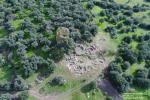Summary (English)
The site of Santa Barbara is situated on a hillside at the edge of a plateau at C. 64 m a.s.l. and c. 1.35 km south-east of the town of Baudladu. The name Santa Barbara de Turre dates to the early 13th century and refers to the domo (rural complex) of the same name mentioned in several of the administrative documents that form the Condaghe di Santa Maria di Bonarcado.
The archaeological complex comprises a complex nuraghe, a village with phases ranging from the Nuragic to medieval periods, a late antique/medieval necropolis, and a curtain wall with towers c. 440 m long surrounding the residential area.After an interruption in the research of 29 years, the 2018 excavations concentrated on the southern sector of the village, where the late antique structures had been identified, in particular the one denominated “structure 9”, a room in a building c. 10 × 6 m, aligned E-W and divided into two rooms. A semi-circular wall was integrated into the east side of the northern perimeter wall, which the excavation revealed to be part of a pre-existing structure. The investigation concentrated on the east room (4 × 3 m) of the building.
After the removal of the post-excavation covering (soil and sand) put down in 1989, a layer of soil mixed with ash and fragments of carbonised wood was uncovered, the result of a fire that destroyed the building and led to its definitive abandonment. Below the layer of burning, there was a hearth area on the east side, attested by the find of several fragments from cylindrical terracotta firedogs and a tile slab covered and surrounded by abundant ash, carbonised vegetal residue and fragments of cooking ware, mainly coarse ware cooking pots datable to between the 5th and 6th century A.D. The floor surface of beaten earth was contemporary with the hearth, and was altered by the intense heat of the fire that destroyed the building. Close to the threshold, on its south side, several nails and other iron elements from the door were found together with several fragments of well-preserved carbonised wood from the door itself.The beaten earth floor rested on a loose foundation of middle-sized stones collected on the site. The terminus post quem for its construction was provided by a fragment of ARS Hayes 84 (second half of the 5th – first quarter of the 6th century A.D.). The removal of the loose foundation revealed a semi-circular wall, the continuation of the wall identified to the exterior of the northern perimeter wall. This was what remained of a circular hut whose walls were partially dismantled to allow the construction of the floor in the late antique building and reuse the blocks, and partially saved, in the exterior part of the wall, to be reused. In fact, a dividing wall was built from the external wall to create two small storerooms. Fragments of a Late Roman amphora and some faunal remains were found inside the eastern storeroom. The continuation of the investigation inside the building revealed the pre-existing walls and thus the plan of the nuragic hut, which had an external diameter of c. 6 m. The nuragic phases produced a large quantity of ceramic materials: spindle whorls, rims, bases, handles, datable to between the late Bronze Age and the early Iron Age (13th – 10th century B.C.).
- Giuseppe Maisola-Dipartimento di Storia, Scienze dell’Uomo e della Formazione – Università degli Studi di Sassari
Director
- Giuseppe Maisola-Dipartimento di Storia, Scienze dell’Uomo e della Formazione – Università degli Studi di Sassari
Team
- Annalucia Corona
Research Body
- Università degli Studi di Sassari
Funding Body
- Comune di Bauladu (Or)






![Download [PDF]](/excavation/skins/fasti/images/results/download_sml.png)